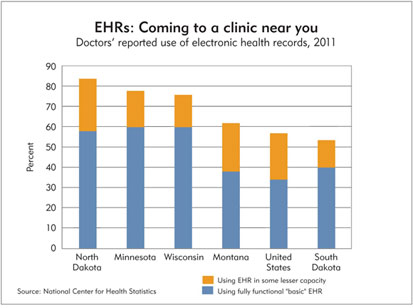In the future, advocates hope to make health care a keystroke away for all patients. But for some, it’s already a reality, even if their doctor is eating lunch—in Estonia.

Christopher Tashjian, a doctor with the Ellsworth (Wis.) Medical Clinic, was one of the first physicians in the country to have his practice recognized by the federal government for using electronic health records (EHRs). While checking his email in a McDonald’s during a vacation in Estonia, Tashjian read an urgent message from a patient whose blood pressure medication had run out. After accessing the patient’s medical record from his mobile phone, he sent off an electronic refill notice to a nearby pharmacy.
“I didn’t want her to go without medication or have to come into the clinic to get one,” said Tashjian. “The whole thing took about a minute to get done.”
That’s precisely the promise of EHRs, which digitize health records, allowing health care organizations to more easily share information among many necessary users, including patients and various health care providers, with the expectation that doing so will improve health care outcomes.
“The question consumers are asking is, ‘We use technology to pay bills and to stay in touch with family and friends, so why shouldn’t providers use technology to improve the care they deliver?’” said Parmeeth Atwal of the Office of the National Coordinator for Health Information Technology, which oversees EHR implementation. “Increasingly, I think it’s an expectation.”
In fact, it’s becoming a reality in district states, which are ahead of most states in EHR implementation. But the nirvana of seamless and sophisticated data sharing is still a considerable distance away, both in the district and elsewhere. Research suggests that, when done properly, EHRs can deliver benefits to patient outcomes and an organization’s bottom line. EHR implementation, however, is rife with technical complications and high startup costs.
Enter the federal government, which has made heaps of money available to encourage EHR installation and help train medical staff in its use, especially those in rural or disadvantaged communities without the financial assets to purchase digital records. While this assistance appears to help medical organizations make the EHR leap, money alone cannot untangle the many transitional challenges that come with electronic health records.
EHRs: Coming to clinic near you?
The National Center for Health Statistics released a report last year that showed that 34 percent of the nation’s office-based physicians used basic but fully functional EHR systems. This includes things like patient history and demographics, clinical notes, medication and allergy lists, and computerized prescriptions. The NCHS report also noted that an additional 23 percent of physicians were using at least some EHR functions, meaning that most physicians are ankle-to-hip deep in digital records.
“That’s huge. … All points say yes to electronic health care records,” said Atwal.
And that’s important because digital records, say advocates, will improve care by giving doctors access to a patient’s history, helping them to determine necessary care and testing through best practices and ensuring that checkups are not missed. E-prescribing eliminates bad handwriting and pharmacy phone calls to double-check the scrawl.
Tashjian, one of the first doctors to meet federal guidelines for meaningful EHR use, is convinced that electronic records provide better care for patients. “You can get a longitudinal view of a patient’s health history as opposed to a snapshot you often get using paper records.”
Existing research on EHRs supports that view. Of the 154 peer-reviewed studies on EHRs from 2007 to 2010, 92 percent found better patient outcomes and other positive results from EHRs, according to a study done by the Office of the National Coordinator for Health Information Technology. In a New England Journal of Medicine 2008 study, physicians reported that EHRs improved patient communication, enhanced decision support with alerts and reminders, improved billing accuracy and prescribing, reduced paperwork and made referrals simpler.
“Just think of diabetics losing their limbs because of the disease and how improved care could allow them to avoid that fate,” said Tashjian. In fact, a study of 27,000 diabetics in the September 2011 New England Journal of Medicine found that “EHR sites were associated with significantly higher achievement of care and outcome standards and greater improvement in diabetes care.” And saving patients from surgery and a challenging recovery should translate into savings for patients and insurance plan sponsors, whether private employers or government.
Ninth District: Leaders, not laggards
But EHRs are exceedingly complex because of the sheer quantity of data generated by the many health care providers (even within a single health care organization) and their propensity for having different—and incompatible—information technology systems.
As a result, EHR development and implementation is geographically lumpy. Most of the country trails the progress of Ninth District states. Minnesota, North Dakota and Wisconsin are considerably ahead of the national average in terms of EHR penetration (see chart). Montana and South Dakota lag behind those states, but exceed the national average of doctors using fully functional EHRs.
That shouldn’t necessarily be a surprise. Most of the region’s patients are served by “integrated delivery systems”—health-speak for large hospital and clinic networks. Becky Schierman, manager of quality improvement for the Minnesota Medical Association, said having an EHR in those settings makes economic sense because physicians within the system can more easily share data on patients who go to one clinic for primary care and another for specialized treatment. “You probably don’t find [high] adoption rates in states where there are still a large number of small, independent practices.”
Schierman added that Minnesota was an early adopter, thanks to a state law—passed prior to similar federal legislation in 2009—that called for all practitioners to be using EHRs by 2015 and to be e-prescribing by 2010. Minnesota also offers incentives to providers for EHR adoption in addition to federal incentives.
The situation is largely the same elsewhere in the district. Sheldon Wolf, North Dakota’s health information technology director, said that more than 70 percent of the state’s population is served by a half-dozen regional health care systems, such as Sanford and Essentia Health. North Dakota also has a $10 million loan fund to help providers pay for costs associated with EHRs.
Most South Dakota residents receive care through large systems like Avera and Sanford Health, which have had EHRs for more than a decade, according to Kevin DeWald, the state health information technology coordinator. “Our integrated delivery networks were early adopters of EHRs.”
How high can you jump?
But obstacles abound to faster EHR integration and development of more sophisticated applications. For example, despite the promise of data sharing, concerns over privacy and control of patient data have cropped up, adding to the complexity—and cost—of EHRs.
Research from a variety of sources, including the Congressional Budget Office, suggests that an EHR requires an upfront investment of $25,000 to $45,000 per physician and does not include annual operations and maintenance. In Wisconsin, many small clinics are considering selling themselves to integrated delivery networks to save the cost of having to buy their own EHR, according to Jesi Wang, project director for the Wisconsin Health Information Technology Extension Center in Madison.
Presumably, the long-term benefits of EHRs outweigh the costs, but it’s not yet a slam-dunk, at least on paper. For example, it can be challenging to monetize improved care outcomes when payments are based on patient visits and procedures—or to capture the financial benefits of greater operational efficiency when reimbursements (particularly from government) are often based on the documented cost of that care. A survey last summer of 500 U.S. health practitioners by athenahealth, a web-based health care management company, found that three-quarters of physicians think EHRs can improve patient care, but 88 percent said that cost remains a big issue for implementation.
“I think one of the biggest challenges and one of the biggest barriers is money for buying the systems,” said Jeff Pickett, who works with many rural providers in South Dakota as marketing and training coordinator for the nonprofit consultancy HealthPOINT. “In addition to the software and hardware costs, there’s a fear that whatever they buy might have to be purchased again [for upgrades] in the future.”
To encourage more EHR investment, in 2009 Congress passed the Health Information Technology for Economic and Clinical Health Act (HITECH), part of the federal stimulus bill at the time, offering providers both carrots and castor oil for adopting more seamless and integrated health record keeping.
For starters, HITECH created a $27 billion EHR incentive fund to help clinics, hospitals and physicians pay for an EHR or upgrade one over the next decade. In tandem with this money, the Centers for Medicare and Medicaid Services established an initial set of 25 EHR guidelines for so-called meaningful use, which includes things like e-prescriptions and electronic access to laboratory and imaging results. Medicare and Medicaid providers (physicians and other eligible professionals, as well as hospitals) implementing at least 20 of these guidelines receive payments to defray EHR costs.
Incentive payments began in January 2011, and $1.3 billion had been disbursed as of December. Eligible Wisconsin providers received more than $76 million, and Minnesota $33 million; those in South Dakota have received $1.3 million, Montana $949,000 and North Dakota just $18,000. Sources said the large payment disparity among states is partly a function of when individual states got their EHR-based reimbursement programs for Medicaid and Medicare providers in place.
And for those lagging in implementation, there are consequences. Hospitals and clinics that do not have an EHR under way by 2015 could see their Medicare reimbursements dinged by 1 percent, and by an additional 1 percent every subsequent year.
Reaching rural providers
Proper training is also a constant drag on integration. EHR training at small, rural clinics and hospitals often goes begging “because getting staff out there from a vendor to answer their questions is very expensive,” said Paul Kleeberg, a doctor who heads up Key Health Alliance, a regional assistance center for Minnesota and North Dakota. “Distance creates big challenges.”
In response to that challenge, the HITECH act set aside $677 million for the creation of nonprofit regional extension centers like Key Health Alliance. These organizations help health care providers—and particularly small, primary care offices and rural hospitals—select EHR vendors and train staff. Modeled on agricultural extension centers found throughout the country, the health-care-related centers hoped to help 100,000 primary care physicians within two years, a goal it achieved in mid-November. The program is designed to make the centers self-funded after a few years, drawing on consulting fees from providers.
Centers located in the district report that they have met or are approaching their recruiting goals for physician training. HealthPOINT, the regional extension center at South Dakota State University, has a goal of helping 800 health care providers and is nearly there, according to Pickett. Many clients are clinics with one to 10 doctors, he said, which constitute the majority of the state’s physician population.
Wang, head of the Wisconsin Health Information Technology Extension Center, said her organization works with a lot of small practices in the northwestern part of the state and has signed up more than 1,700 small clinic physicians, nurses and staff at 45 of the state’s 59 smaller hospitals, defined as 50 beds or fewer. “I think we see broadband challenges and less ability to see best practices from their neighbors because they’re fewer and far in between,” she said. Thanks in part to training, providers “are learning they can get [EHRs] done, and it will improve their care.”
Though Montana’s official EHR measures are ahead of the national average, the state “is a little bit behind the rest of the country,” conceded Dan Maronick, marketing and outreach manager for Helena-based Health Technology Services, the regional extension center that covers Montana and Wyoming. One reason is because the state does not have many integrated medical networks.
Maronick said the majority of hospitals and clinics in Montana are installing EHRs, “but some are saying they don’t care about incentive money and that their paper system works fine. Some of the physicians are about to retire and don’t want the bother.”
But momentum for EHRs appears to be growing in the state. Maronick said his organization has attracted 900 physicians, just 100 short of its goal. About 80 percent of the region’s 60 critical access hospitals—defined as 25 beds or more—have signed up for services, said Maronick. Many clients already have EHRs, but need help with training and adding functions to reach meaningful use. “We come in with IT experts and people who know ‘meaningful use,’ and we help them get up to speed so they can get their EHR incentive money,” said Maronick.
Take two aspirin and boot up in the morning
Despite the assistance, much work lies ahead before EHRs are fully functional in the broadest sense. For example, current EHR implementation focuses mostly on data sharing among providers in the same network or system; EHRs do not yet seamlessly share patient data with other independent care systems (also called interoperability).
 Avera Medical Group and the Brookings Health System hospital stand next to each another in Brookings, S.D. Both have an EHR from the software vendor Meditech, but the two systems don’t automatically exchange data because different companies own each institution, said Brian Sterud, the hospital’s information management director. Clinic physicians now simply log on to Brookings’ Meditech EHR to enter data on patients they have seen at the hospital rather than use their office’s EHR.
Avera Medical Group and the Brookings Health System hospital stand next to each another in Brookings, S.D. Both have an EHR from the software vendor Meditech, but the two systems don’t automatically exchange data because different companies own each institution, said Brian Sterud, the hospital’s information management director. Clinic physicians now simply log on to Brookings’ Meditech EHR to enter data on patients they have seen at the hospital rather than use their office’s EHR.
To address interoperability, every state has to create a health information exchange (HIE) to enable noncompatible platforms to send and receive health data to and from each other. Wang sees it as a “network of networks” allowing physicians to use a state exchange to move patient data among Wisconsin care providers now, and later with other HIEs nationally. No state has an HIE up and running, although the federal government has contributed $400 million toward their creation.
Not all institutions are waiting for HIEs to be created. Several large hospitals in the Twin Cities collectively selected Epic as their EHR vendor in part because they believed one platform was a better way to quickly share health records.
Technical and bureaucratic obstacles also abound for both small and large providers. For instance, meaningful use standards—and the financial incentives they bring in tow—have introduced some unexpected problems. Kleeberg said that some large Minnesota hospitals and clinics already had sophisticated digital records for a number of years, but failed to meet federal criteria for meaningful use.
“We have been slow as a state to become meaningful users in our larger, more established facilities because we’re already doing well beyond what’s required, and it’s harder to change a battleship than a boat,” Kleeberg said. “Many of these places have built these great systems, but now they have to change the battleship.”
If the move toward EHRs sounds complex, confusing and expensive, well, it is. Martin LaVenture, director of the Center for Health Informatics at the Minnesota Department of Health, calls EHRs a “multistep” journey that will improve as “gaps and barriers” are overcome and best practices inform new capabilities and assist in their implementation.
“We have adoption, but we have a long ways to go on effectively using electronic health records, including the exchange,” LaVenture said. “The exchange represents the next wave of what we think needs to be achieved.”






